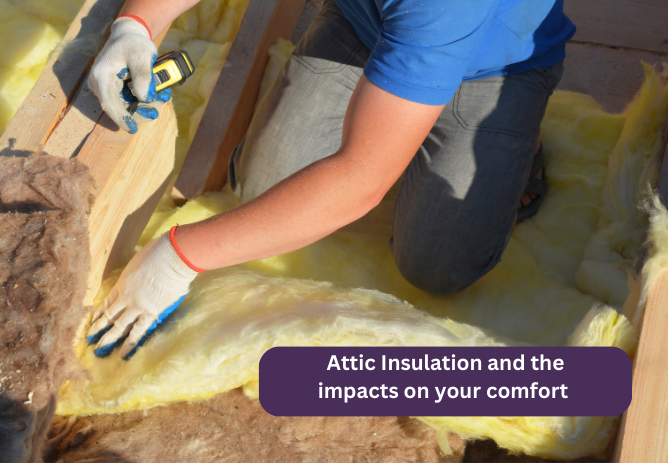24 August 2023
Attic Insulation Upgrades and its Impacts
Why Install Attic Insulation and What Impact can it Have?
On average, a home loses 20-30% of its heat through its roof, if it is not properly insulated. A home that is under-insulated is more vulnerable to outside temperature as heat naturally flows from hot to cold. It’s the same principal as us wearing a hat in winter to stay warm or in summer to help keep us cooler. Even if you have attic insulation it is worth checking out to make sure there is a sufficient amount and that it’s deep enough and also to make sure it isn’t damaged.
This loss of heat through your attic not only costs you money in the form of higher heating bills, but it also harms the environment by increasing greenhouse gas emissions. Properly insulating your attic will;
- make your home feel more comfortable. You’ll feel warmer in the winter and cooler in the summer,
- lower your energy bills,
- help reduce greenhouse gas emissions, and
- improve your home’s energy rating.
Your home’s energy rating is important when it comes to selling your home – or indeed buying a new one. In the Republic of Ireland this is called your Building Energy Rating Certificate (BER). By law, all new houses and all houses for sale or rent must have a BER. The more energy efficient your home is, the easier it is to sell or rent so you can expect the higher your BER cert is to positively impact the value of your property. The Energy Performance Certificate (EPC) is a similar measure which is used for homes in Northern Ireland (NI).
Attic Insulation Costs & Savings
The SEAI (The Sustainable Energy Authority of Ireland) estimate, that for a four bed detached house of 150sqm using fibreglass insulation, it would cost between €700 and €1,000 (excluding grants*) to upgrade to the recommended 300m depth of insulation. For a house of this size with an energy bill of €1,600 p.a., upgrading to this level of attic insulation could result in savings of around €250 per annum. Attic insulation is generally the most cost effective of any energy efficiency upgrade made to a house, considering the potential cost savings that can be achieved on monthly heating bills.
Attic Insulation Grants
The SEAI have grants for Rep. of Ireland home owners of up to €1,500 for insulating your attic.
Types of Attic Insulation
The best type of insulation for your attic depends on the structure and build of your house.
Ceiling Level Insulation
Houses with pitched roofs and an empty attic space can be insulated with special quilted blankets layered in opposite directions. There are other options available so when choosing a product, you should ask your supplier or contractor to demonstrate how and why the product meets the performance requirements of the relevant grant programme if applicable, and to ensure that it complies with all relevant building regulations.
Rafter Level Insulation
This insulation is fitted between the rafters of the roof. In houses where the attic has been converted to a living space, this type of insulation is used. It provides a warm attic space but is usually more expensive to install. Depending on your home, you may want to combine ceiling level and rafter level insulation for the best savings. A specialist insulation contractor would be best to seek advice from as to the best solution for you.
Flat Roof Insulation
Flat roofs can benefit from added insulation on the inside ceiling (reducing your ceiling height) or an external layer on the roof. Many choose to opt for an internal plaster board with insulation and a vapour control layer.
Attic Insulation - Top Tips
- Bedrooms located on upper floors are especially vulnerable to outside temperatures. Adding insulation to your attic space is a great way to ensure these rooms stay temperate at night and in the early morning, when temperatures are at their lowest. Therefore, it is important, where possible, to minimise the amount of items stored in the attic which may compact or compress the insulating material and affect its ability to insulate. Try to make certain that the storage area set aside is located over an area of the house which has a lower heating requirement, e.g. over bathrooms as opposed to the bedrooms. Alternative arrangements like raised storage areas above the level of the insulation could also be discussed with your contractor.
- Don’t forget to insulate your water tank and pipes! When you’ve properly insulated your ceiling level, the temperature in the attic will be reduced, so insulating the water tank and pipes will protect them from lower temperatures and ensure they don’t freeze during cold snaps. This will also help to minimise heating costs associated with heating water!
- Ventilation is important in an attic to help prevent damp or mould from occurring. Therefore, it is important to ensure ventilation openings at the eaves of the house are left unblocked after installation of your insulation.
- Recessed lighting/downlighters should be provided with sufficient space around them to allow heat to dissipate so as to prevent the lights themselves from overheating and creating a fire hazard.
- Install a permanent walkway in your attic to ensure you have easy access to water tanks and storage areas, without compromising the effectiveness of the insulation.
- Don’t forget about the attic hatch and make sure that it too is insulated!
Green Home Improvement Loan
If you need any help to fund a warmer, greener home, why not take a look at our Green Loan HERE it is at a reduced Loan Interest Rate of 7.25% APR.








